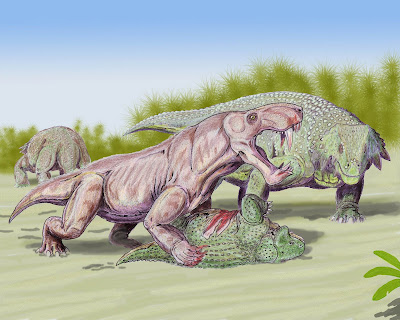Adam’s paper: Huttenlocker, A. K., and J. Botha-Brink. 2013. Body size and growth patterns in the therocephalian Moschorhinus(Therapsida) before and after the end-Permian extinction in South Africa. Paleobiology. 39:253-277. doi: http://dx.doi.org/10.1666/12020
The K-Pg extinction, responsible for the catastrophic ecosystem collapse that blotted out the non-avian dinosaurs some 65 million years ago, is ostensibly the best-known extinction event in the entire history of Earth. But surprisingly few people are aware of an even greater event that disrupted links in communities on land and in the oceans during the Earth’s last major icehouse-hothouse transition about 252 million years ago: the end-Permian extinction. This event shared many characteristics with the K-Pg extinction, but with a much higher death toll, wiping-out nearly 90% of animal species. It is estimated that animal communities did not return to their former ecological diversity until some eight million years later, during the Middle Triassic.
 |
Huge gorgonopsians and their prey went extinct at the close of the Permian Period (ca. 252 million years ago). (artwork: Dmitry Bogdanov) |
The identification of common themes between extinctions (and across marine and non-marine environments) has endowed historical biologists with predictive tools as the world faces new ecological challenges. Scientists who study mass extinctions are in a unique position to determine common patterns of degradation and collapse, reconstructing the progression of an extinction, identifying its parts and phases (e.g., initial extinction, survival, and recovery phases) and the underlying characteristics of each phase. With respect to these phases, paleontologists have become increasingly interested in the common historical and biological factors that influence recoveries, allowing some groups to flourish and take hold of new ecological opportunities in a post-extinction world.
Several of the Big Five extinctions are characterized not only by reductions in species numbers and abundance, but also by the small body sizes of putative disaster taxa—the Lilliput phenomenon (which pulls its name from the tiny inhabitants of the island of Lilliput in Jonathan Swift’s classic Gulliver’s Travels). Terms like ‘Lilliput taxa,’ ‘Lazarus taxa,’ ‘Elvis taxa,’ and ‘dead clade walking’ are just a few of a grocery list of idioms that researchers have invented to describe specific attributes of survivor and recovery taxa. Unfortunately, the underlying mechanisms producing species that fit these monickers may not always be as easy to identify. For example, temporary body size reductions in Lilliput taxa could result from a size-selective extinction in which pre-existing large-bodied species became extinct (leaving only small survivor taxa), but could also arise from within-lineage size decreases (e.g., heterochronic processes acting within survivor lineages). Consequently, growth data from species within clades that survived major extinctions (such as the end-Permian extinction) are now providing insights into the influences of Lilliputian patterns following extinction events.
Temporary post-extinction body size reductions have been well-documented in many marine invertebrate groups following the end-Permian extinction, including gastropods, conodonts, foraminifera, and brachiopods. Recent work on Early Triassic brachiopod shells from northern Italy suggests that not only did miniaturized versions of pre-extinction taxa persist in the disaster fauna, they achieved their unusually small sizes by slowing down their overall skeletal growth rates (inferred by counting and measuring tiny annual growth rings recorded in the shell of the animal—a technique called ‘sclerochronology’).
In spite of these developments in invertebrate paleontology, there has been a lag in studies of terrestrial vertebrate growth and life history patterns in the aftermath of extinctions. In an article published this month in Paleobiology, my coauthor, Jennifer Botha-Brink, and I identify differences in body size and growth patterns in a single vertebrate genus from the Permo-Triassic boundary of the Karoo Basin of South Africa: Moschorhinus kitchingi, an extinct forerunner of mammals or ‘therapsid.’ We collected body size data in stratigraphically successive populations of Moschorhinus and histologically thin-sectioned limb bones to study their microstructure as a means of understanding changes in skeletal growth. The study partly corroborates recent observations on body size reductions in earliest Triassic marine invertebrates, but provides additional life history data indicating that observed size variation over geologic time is owed largely to differential juvenile growth rates and growth duration. Interestingly, Triassic Moschorhinus (and perhaps other Karoo vertebrates) did not exhibit slower growth rates like the Italian brachiopods, but instead displayed fast, relatively sustained growth over fewer growing seasons. Our work suggests the possibility that Lilliputian phenomena in marine and non-marine taxa were influenced by different processes. Differences in marine and non-marine biotic responses underscore the need to study the phylogenetic and life history components of Lilliputian phenomena, improving our ability to address causality during mass extinctions.
–Adam Huttenlocker, Ph.D. CandidateUniversity of Washington, Department of Biology
Further Reading:Harries PJ & Knorr PO (2009) What does the ‘Lilliput Effect’ mean? Palaeogeography, Palaeoclimatology, and Palaeoecology 284:4–10.Huttenlocker, A. K., and J. Botha-Brink. 2013. Body size and growth patterns in the therocephalian Moschorhinus (Therapsida) before and after the end-Permian extinction in South Africa. Paleobiology. 39:253-277. Metcalfe B et al. (2011) Size and growth rate of ‘Lilliput’ animals in the earliest Triassic. Palaeogeography, Palaeoclimatology, Palaeoecology 308:171–180.Retallack GJ (In press) Permian and Triassic greenhouse crises. Gondwana Research. doi: 10.1016/j.bbr.2011.03.031Twitchett RJ (2007) The Lilliput effect in the aftermath of the end-Permian extinction event. Palaeogeography, Palaeoclimatology, and Palaeoecology 252:132–144.


